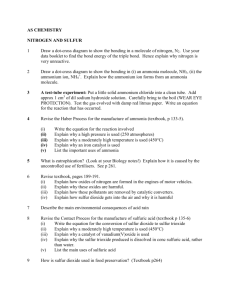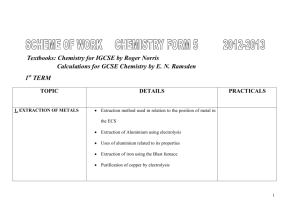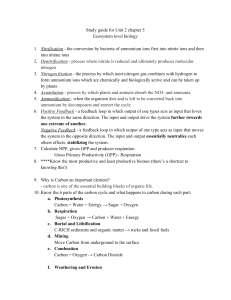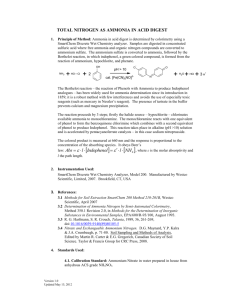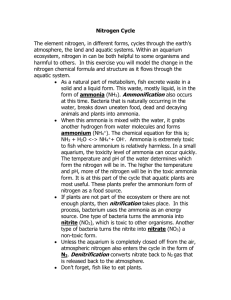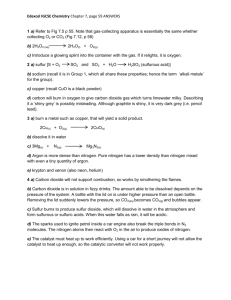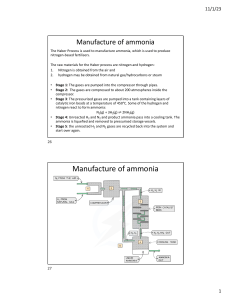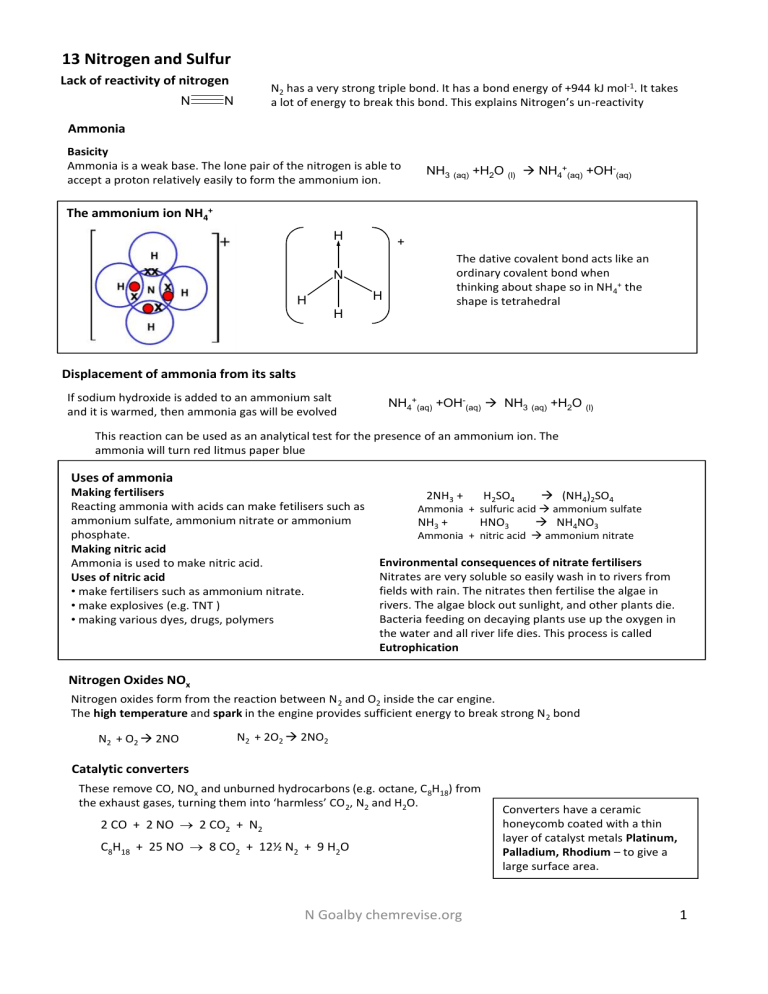
13 Nitrogen and Sulfur Lack of reactivity of nitrogen N N2 has a very strong triple bond. It has a bond energy of +944 kJ mol-1. It takes a lot of energy to break this bond. This explains Nitrogen’s un-reactivity N Ammonia Basicity Ammonia is a weak base. The lone pair of the nitrogen is able to accept a proton relatively easily to form the ammonium ion. NH3 (aq) +H2O (l) NH4+(aq) +OH-(aq) The ammonium ion NH4+ + H + The dative covalent bond acts like an ordinary covalent bond when thinking about shape so in NH4+ the shape is tetrahedral N H H H Displacement of ammonia from its salts If sodium hydroxide is added to an ammonium salt and it is warmed, then ammonia gas will be evolved NH4+(aq) +OH-(aq) NH3 (aq) +H2O (l) This reaction can be used as an analytical test for the presence of an ammonium ion. The ammonia will turn red litmus paper blue Uses of ammonia Making fertilisers Reacting ammonia with acids can make fetilisers such as ammonium sulfate, ammonium nitrate or ammonium phosphate. Making nitric acid Ammonia is used to make nitric acid. Uses of nitric acid • make fertilisers such as ammonium nitrate. • make explosives (e.g. TNT ) • making various dyes, drugs, polymers 2NH3 + H2SO4 (NH4)2SO4 Ammonia + sulfuric acid ammonium sulfate NH3 + HNO3 NH4NO3 Ammonia + nitric acid ammonium nitrate Environmental consequences of nitrate fertilisers Nitrates are very soluble so easily wash in to rivers from fields with rain. The nitrates then fertilise the algae in rivers. The algae block out sunlight, and other plants die. Bacteria feeding on decaying plants use up the oxygen in the water and all river life dies. This process is called Eutrophication Nitrogen Oxides NOx Nitrogen oxides form from the reaction between N 2 and O2 inside the car engine. The high temperature and spark in the engine provides sufficient energy to break strong N 2 bond N2 + O2 2NO N2 + 2O2 2NO2 Catalytic converters These remove CO, NOx and unburned hydrocarbons (e.g. octane, C8H18) from the exhaust gases, turning them into ‘harmless’ CO 2, N2 and H2O. 2 CO + 2 NO 2 CO2 + N2 C8H18 + 25 NO 8 CO2 + 12½ N2 + 9 H2O N Goalby chemrevise.org Converters have a ceramic honeycomb coated with a thin layer of catalyst metals Platinum, Palladium, Rhodium – to give a large surface area. 1 Nitrogen oxide Pollutants NOx gases react to form smog and acid rain in the atmosphere Nitrogen monoxide can react in the atmosphere to form nitrogen dioxide 2NO+ O2 2NO2 Nitrogen dioxide catalyses the conversion of sulphur dioxide to sulphur trioxide. The first step of the reaction is NO2 (g)+ SO2 (g) SO3 (g) + NO(g) The second step of the reaction is NO (g)+ ½ O2 (g) NO2 (g) The nitrogen dioxide is regenerated at the end of the reaction so is classed as a catalyst. Sulfur: the formation of atmospheric sulfur dioxide Sulfur containing impurities are found in petroleum fractions which produce SO2 when they are burned. S+ O2 SO2 CH3SH+ 3O2 SO2 + CO2 + 2H2O Coal is high in sulfur content, and large amounts of sulfur oxides are emitted from power stations. The sulfur dioxide goes on to form acid rain In the first step reactions in the atmosphere form SO3 2SO2 + O2 2 SO3 The SO3 dissolves in atmospheric water to form acid SO3 + H2O H2SO4 sulphuric acid Consequences of acid rain • Decline in fish populations in rivers • Dissolves minerals Mg, Ca, and K from the soil • Dissolves waxy coatings that protect leaves from bacteria • Corrodes metals, and limestone buildings N Goalby chemrevise.org 2
